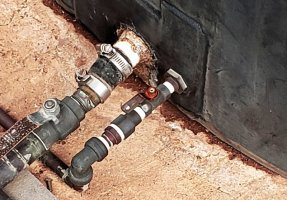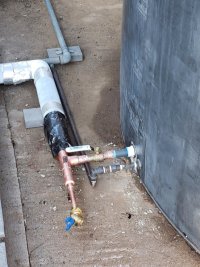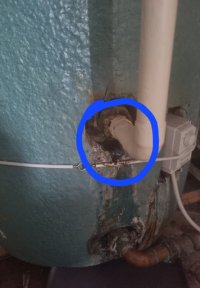Heimhenge
New Member
Just joined this forum and this is my first post. Looks like the perfect community for my question.
I have a 2000 gallon poly water storage tank fed by my well. Well production has been dropping (Arizona drought) and I had to have my tank commercially refilled for the first time in a few years. Shortly after that I discovered the tank was leaking around the outlet fitting. When full, there's around 2.3 PSI at the bottom of the tank, and the outlet fitting hadn't seen that much pressure in awhile.
History: The PVC fitting was the recommended one for a poly tank. It was installed 15 years ago as per instructions in a dry tank. Worked fine for many years and then developed a leak. Probably from tank flex when filling or when it warms up. The tank is shaded by an overhead lattice, but some direct sunlight still gets to the outlet fitting.
My solution was to replace the rigid connection between the tank outlet and the house plumbing with a short length of radiator hose held by stainless hose clamps. That was preemptive to compensate for flex. The leak was where the PVC outlet penetrated the tank. To plug that I used "plumbers epoxy" and molded it around the perimeter of the outlet fitting, as you can see in the photo. Of course, I roughed up the surface of the tank and PVC beforehand. That held fine for years until last week, when the new leak was discovered.
So now I need some advice. FlexSeal is not rated for potable water. Plumbers tape is temporary. Draining the tank and installed a new fitting from the inside is something I really don't want to do. My current plan is to clean off all the calcium carbonate crud, rough up the residual surface, and then apply another layer of plumbers epoxy to reseal it. Won't fill the tank again until it's had plenty time to cure.
If anyone can suggest a better solution it would be most appreciated. Thanks!
I have a 2000 gallon poly water storage tank fed by my well. Well production has been dropping (Arizona drought) and I had to have my tank commercially refilled for the first time in a few years. Shortly after that I discovered the tank was leaking around the outlet fitting. When full, there's around 2.3 PSI at the bottom of the tank, and the outlet fitting hadn't seen that much pressure in awhile.
History: The PVC fitting was the recommended one for a poly tank. It was installed 15 years ago as per instructions in a dry tank. Worked fine for many years and then developed a leak. Probably from tank flex when filling or when it warms up. The tank is shaded by an overhead lattice, but some direct sunlight still gets to the outlet fitting.
My solution was to replace the rigid connection between the tank outlet and the house plumbing with a short length of radiator hose held by stainless hose clamps. That was preemptive to compensate for flex. The leak was where the PVC outlet penetrated the tank. To plug that I used "plumbers epoxy" and molded it around the perimeter of the outlet fitting, as you can see in the photo. Of course, I roughed up the surface of the tank and PVC beforehand. That held fine for years until last week, when the new leak was discovered.
So now I need some advice. FlexSeal is not rated for potable water. Plumbers tape is temporary. Draining the tank and installed a new fitting from the inside is something I really don't want to do. My current plan is to clean off all the calcium carbonate crud, rough up the residual surface, and then apply another layer of plumbers epoxy to reseal it. Won't fill the tank again until it's had plenty time to cure.
If anyone can suggest a better solution it would be most appreciated. Thanks!



